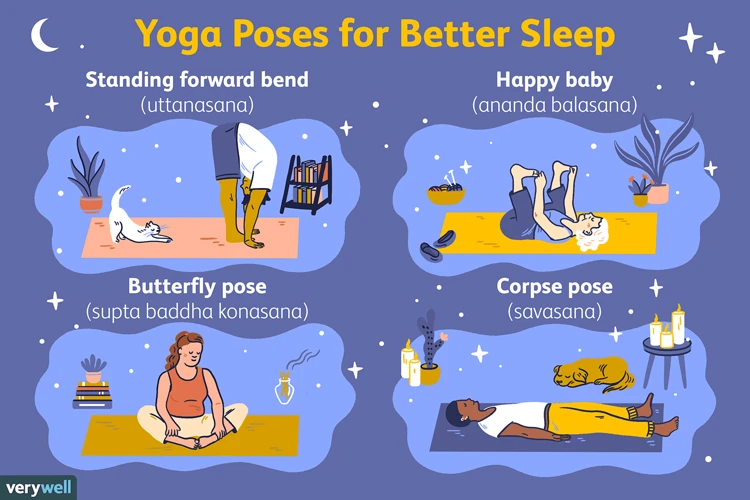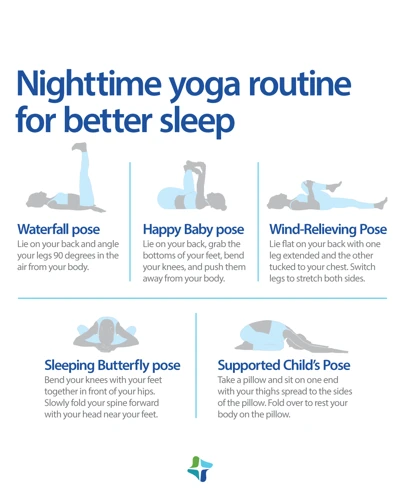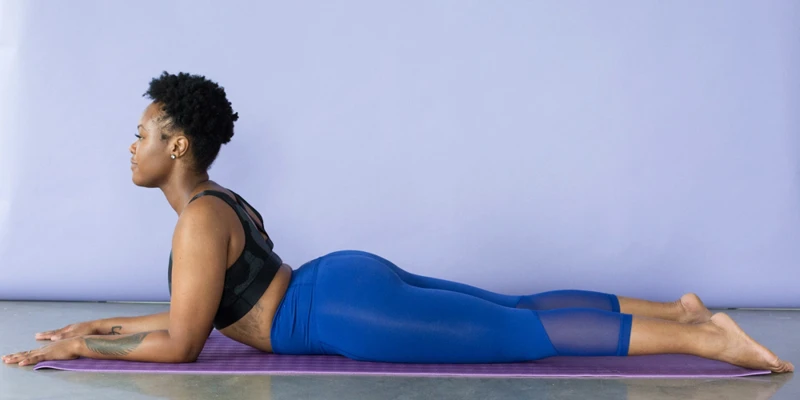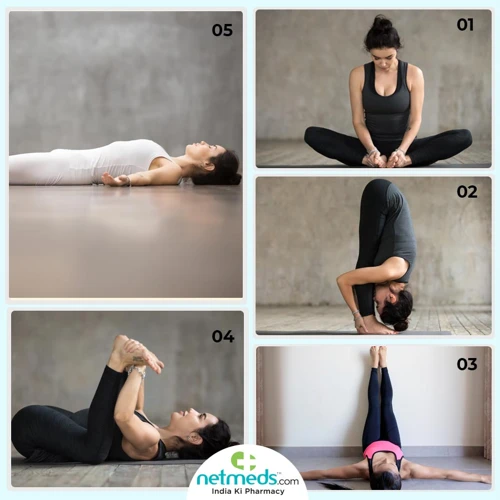Do you often find yourself tossing and turning in bed, struggling to fall asleep? Or maybe you wake up feeling restless and exhausted, unable to get the restorative sleep your body needs? If this sounds familiar, know that you’re not alone. Many people today experience sleep problems due to stress, anxiety, and various other factors. The good news is that there are simple, natural ways to improve your sleep quality and promote relaxation. One of the most effective methods is through yoga and stretching exercises. In this article, we’ll delve into the science behind yoga and stretching for better sleep, and explore some of the most beneficial yoga poses and stretching exercises you can do to help you unwind and get the rest you deserve.
The Science Behind Yoga and Stretching for Better Sleep

Have you ever experienced trouble falling asleep, even when you feel exhausted? You’re not alone. Many people struggle with getting quality sleep, and this can be due to various factors, including stress and anxiety. But did you know that incorporating yoga and stretching exercises into your routine can potentially promote better sleep? Through scientific studies, the benefits of these practices have been shown to positively impact sleep quality. Let’s delve into the reasons why yoga and stretching are effective and how they work.
Effects of Stress on Sleep Quality
Stress is an inhibitor of quality sleep. The effects of stress on sleep quality can be numerous and severe, affecting a person’s well-being in multiple ways. Here are some of the ways in which stress can affect sleep quality:
- Anxiety: Anxiety can be both a cause and an effect of stress. When a person is anxious, their mind is agitated, making it difficult to fall asleep. Anxiety can also cause a person to wake up in the middle of the night and have trouble getting back to sleep again.
- Racing thoughts: When a person is stressed, their mind often races with thoughts, making it challenging to relax and fall asleep. Racing thoughts can cause a person to stay awake for hours, leading to a reduction in the quantity and quality of sleep.
- Increased cortisol levels: Cortisol is a hormone produced by the body in response to stress. Increased cortisol levels can disrupt the sleep cycle and lead to a reduction in sleep quality.
- Physical tension: Stress often leads to physical tension in the body, with the muscles becoming tight and rigid. This tension can cause discomfort and pain, making it difficult to fall asleep or stay asleep.
Stress can have a severe impact on sleep quality, leading to a wide range of negative consequences. It’s essential to take steps to reduce stress and promote relaxation before bedtime to improve sleep quality. Yoga and stretching exercises are a great way to accomplish this.
Benefits of Yoga and Stretching for Sleep
Engaging in regular yoga and stretching practices can greatly improve and support the quality of sleep. Here are some of the benefits:
- Reduces stress: Yoga and stretching can decrease the levels of the stress hormone, cortisol in the body, which can help to calm the mind and reduce feelings of anxiety.
- Promotes relaxation: By practicing gentle and restorative poses, the body and mind are able to let go of tension and find a deeper state of relaxation, facilitating a more peaceful and restful sleep.
- Improves flexibility: Stretching regularly can increase overall flexibility, which can help to reduce muscle tension and pain that may be keeping you awake at night.
- Reduces physical discomfort: Specific stretches and poses can target and alleviate physical discomfort in areas such as the neck, back, and hips, that may be contributing to poor sleep.
- Enhances overall body awareness: By tuning into the body’s sensations during a yoga or stretching practice, individuals can gain a greater awareness of their own physical and emotional state, aiding in relaxation and mindfulness.
Incorporating these practices into your daily routine can provide a multitude of benefits that go beyond just improving sleep quality.
Yoga Poses for Relaxation and Better Sleep

If you struggle to fall asleep at night, incorporating yoga into your bedtime routine may be just what you need. Not only does yoga provide physical benefits, but it also helps calm the mind and reduce stress levels. Here are a few yoga poses that will help you relax and get better sleep.
Child’s Pose (Balasana)
One yoga pose that is great for relaxation and inducing sleep is Child’s Pose, also known as Balasana. This pose targets the hips, thighs, and back, releasing tension in these areas and promoting a sense of calmness.
To perform this pose, follow the steps outlined in the table below:
| Step 1: | Kneel on the floor and sit back on your heels. |
| Step 2: | Slowly lower your forehead to the floor, with your arms outstretched in front of you. |
| Step 3: | Relax your entire body and breathe deeply for several minutes. |
| Tips: | For added comfort, place a cushion or folded blanket under your head or knees. |
Child’s Pose is a gentle way to stretch the back muscles and calm the mind, making it an ideal pose for relaxation before sleep. Remember to focus on your breath, allowing each inhale and exhale to deepen your sense of relaxation. With regular practice, Child’s Pose can become a go-to pose for getting a good night’s rest.
Legs-Up-The-Wall Pose (Viparita Karani)
One highly effective yoga pose for relaxation and better sleep is the Legs-Up-The-Wall Pose, also known as Viparita Karani.
To perform this pose, follow these steps:
- Find an empty wall space and sit sideways with one hip against the wall.
- Lie down on your back and keep your legs up against the wall.
- Adjust your hips and buttocks so they are touching the wall and your legs are resting against it.
- Place your hands on your belly or rest them by your side.
- Close your eyes and relax into the pose, taking deep breaths.
- Hold the pose for 5-10 minutes or as long as you’re comfortable.
This pose is highly beneficial for relaxation because it helps to calm the nervous system and reduce stress and anxiety. By elevating the legs above the heart, it also helps to improve blood circulation and reduce inflammation in the legs and feet.
Legs-Up-The-Wall pose is also known to help improve sleep quality as it promotes deep relaxation and a meditative state of mind. It is especially helpful for individuals who suffer from insomnia or have trouble falling asleep due to stress or anxiety.
Incorporating this pose into your nightly routine can be highly beneficial for improving sleep quality and promoting relaxation for both the mind and body.
Corpse Pose (Savasana)
One yoga pose that is particularly effective for relaxation and better sleep is the corpse pose, also known as Savasana. This pose involves lying flat on your back with your arms at your sides and your legs slightly apart. Here are some tips for getting the most out of this pose:
- Focus on your breath: As you lie in Savasana, close your eyes and focus on your breath. Take deep, slow breaths, inhaling and exhaling through your nose. Let your breath become slow and even, and with each exhale, allow your body to release any tension it may be holding.
- Scan your body: Once you have settled into the pose, take a few moments to mentally scan your body from head to toe. Identify any areas of tension or discomfort, and consciously release them on each exhale. Imagine that you are sinking deeper and deeper into the floor with each breath.
- Visualize: As you continue to relax in Savasana, you may find it helpful to visualize a peaceful scene, such as a beach or a forest. Focus on the details of the scene—the sound of the waves, the breeze rustling the leaves—and allow yourself to feel as if you are truly there.
- Stay as long as you like: There is no set amount of time you should stay in Savasana—simply stay for as long as you like, or as long as your schedule allows. When you are ready to come out of the pose, begin to deepen your breath and slowly wiggle your fingers and toes. Roll onto your side and pause for a moment before slowly pushing yourself up to a seated position.
Incorporating Savasana into your regular yoga or stretching routine can help you to relax your mind and body, improving your overall sleep quality.
Stretching Exercises for Relaxation and Better Sleep

Stretching exercises are a great way to relax your body and mind before bedtime, which can improve the quality of your sleep. These beneficial exercises help to loosen up your muscles, release tension, and reduce stress levels. Incorporating stretching into your evening routine can help you unwind after a long day, and prepare your body and mind for a restful night’s sleep. In this section, we will explore three stretching exercises that are simple yet effective in promoting relaxation and better sleep.
Neck and Shoulder Stretch
One of the most common areas of tension and tightness that can prevent a good night’s sleep is the neck and shoulders. The Neck and Shoulder Stretch exercise is an excellent way to target these areas and release tension.
To perform this stretch:
- Start by sitting or standing up straight with your arms at your sides.
- Slowly tilt your head to one side, bringing your ear towards your shoulder.
- Using your hand, gently press down on the opposite shoulder to deepen the stretch.
- Hold for 15-30 seconds, breathing deeply and feeling the stretch in the side of your neck.
- Repeat on the other side.
Note: It is important to avoid any bouncing or jerking movements during this stretch, as they can cause injury. Also, be sure to keep your shoulders down and relaxed during the stretch.
Regular practice of Neck and Shoulder Stretch can help reduce tension in these areas, leading to better sleep quality. Additionally, incorporating deep breathing and mindfulness techniques during the stretch can also enhance its relaxation benefits.
Forward Fold (Uttanasana)
One effective stretching exercise for relaxation and better sleep is the Forward Fold, also known as Uttanasana in yoga. This pose focuses on stretching the hamstrings and lower back, which can help relieve tension and stress built up in those areas.
To perform the Forward Fold:
- Stand with your feet hip-distance apart and your hands on your hips.
- Exhale and fold your upper body forward, hinging at your hips. Keep your spine long and straight as you fold forward.
- Allow your hands to rest on the floor in front of you or reach for your ankles or shins.
- Relax your head, neck, and shoulders as you hold the pose for several breaths.
- To release, slowly roll up one vertebra at a time, bringing your head up last.
It’s important to avoid rounding your spine or locking your knees during this pose to prevent injury. If you have tight hamstrings or a history of back injuries, you may need to modify the pose by bending your knees slightly or using blocks to bring the floor closer to you.
Incorporating the Forward Fold into your stretching routine before bed can help release tension in your lower back and hamstrings, promoting relaxation and better sleep quality. Additionally, the meditative aspect of the pose may help calm your mind and prepare you for a restful night’s sleep.
Seated Spinal Twist (Ardha Matsyendrasana)
A great stretching exercise to promote relaxation and better sleep is the Seated Spinal Twist, or Ardha Matsyendrasana in Sanskrit. This gentle twist helps to alleviate tension in the spine, hips, and neck, which are common areas of tightness for many people.
To perform Seated Spinal Twist:
| Step 1: | Sit on the floor with your legs extended in front of you. |
| Step 2: | Bend your right knee and place your right foot on the outside of your left thigh, keeping your left leg straight. |
| Step 3: | Place your right hand behind your back on the floor or on a block. |
| Step 4: | Extend your left arm up and lengthen your spine. |
| Step 5: | Exhale and twist to the right, bringing your left elbow to the outside of your right knee. |
| Step 6: | Hold for several breaths, then release and repeat on the opposite side. |
Remember to breathe deeply throughout the pose, inhaling to lengthen the spine and exhaling to deepen the twist. As with all stretches, it’s important to listen to your body and not push yourself beyond your limits. If you feel any pain or discomfort, ease out of the pose and try again later.
Incorporating Seated Spinal Twist into your bedtime routine can help to release tension and promote relaxation, preparing both body and mind for a restful night’s sleep.
Tips for Incorporating Yoga and Stretching into Your Sleep Routine
If you’re looking to improve the quality of your sleep and feel more relaxed before bedtime, incorporating yoga and stretching into your night routine might be just what you need. But how can you make sure you stick to it and create a habit? In this section, we’ll share some useful tips to help you integrate yoga and stretching into your sleep routine easily and consistently. From finding the best time to practice to creating a calming environment, we’ve got you covered. So, keep reading to learn how to create a bedtime ritual that promotes deep, restful sleep.
Best Time to Practice
When it comes to practicing yoga and stretching exercises for better sleep, the best time to do so may vary depending on an individual’s schedule and preferences. However, there are some general guidelines that can be followed to maximize the benefits of these practices.
1. Evening: Practicing yoga and stretching in the evening, around 1-2 hours before bedtime, can be beneficial in relaxing the body and mind, reducing stress and tension in the muscles, and promoting a better quality of sleep. This can also help shift the focus from the tasks of the day to winding down and preparing for sleep.
2. Morning: Practicing yoga and stretching in the morning, before starting the day, can also be beneficial in energizing the body and mind, improving flexibility and mobility, and setting a positive tone for the day ahead. This can also help reduce stress and tension that may build up during the day, leading to a more restful sleep at night.
3. Breaks throughout the day: In addition to practicing in the morning or evening, taking short breaks throughout the day to stretch and move the body can also be beneficial in reducing stress and tension, improving circulation, and promoting overall well-being.
It is important to note that practicing yoga and stretching exercises at any time of the day can be beneficial for better sleep, and it ultimately depends on an individual’s schedule and preferences. It is recommended to experiment with different times and find what works best for one’s personal needs and lifestyle.
Incorporating a regular yoga and stretching practice into one’s daily routine can lead to improved sleep quality and overall health and well-being. However, it is important to consult with a healthcare professional before beginning any new exercise routine, especially if there are any pre-existing conditions or injuries.
Creating a Relaxing Environment
Creating a Relaxing Environment is crucial to enjoying the benefits of yoga and stretching exercises for better sleep. Here are a few tips to make your environment conducive to relaxation:
| Tip | Description |
|---|---|
| No distractions | Try to eliminate as many distractions as possible. Turn off electronics or put them on silent mode. Choose a quiet and peaceful location where you can focus on the exercises. |
| Comfortable temperature | Make sure the room temperature is comfortable for you. This can differ from person to person, but generally, a cool room is better for sleeping than a warm one. Wear comfortable clothing if necessary. |
| Soft lighting | Use soft lighting, such as candles or dim lights, to create a calming atmosphere. Bright lights can interfere with your circadian rhythms and make it harder to fall asleep. |
| Aromatherapy | Consider using essential oils, such as lavender or chamomile, to help you relax. These scents can have a calming effect on the mind and body. |
| Comfortable props | Use comfortable props such as yoga mats, bolsters, and blankets to support your body and make the exercises more comfortable. They can also help you get into the right position for each pose. |
By creating a relaxing environment, you can enhance the benefits of yoga and stretching exercises for better sleep. Take the time to set up a peaceful location where you can focus on your practice and unwind from the stresses of the day.
Making Yoga and Stretching a Habit
Establishing a regular yoga and stretching routine is key to reap the benefits of these practices for better sleep. Here are some tips for making it a habit:
| Set a Schedule: | Make time in your daily or weekly schedule for yoga and stretching. Choose a consistent time that works for you, perhaps right before bed or in the morning. This way, it will become a part of your routine and easier to stick to. |
| Start Slow: | Don’t try to do an intense one-hour yoga session right away. Start with shorter sessions, such as 10-15 minutes, and gradually build up to longer sessions as your body adjusts. |
| Find a Partner: | Having a friend or family member to practice with can make it more enjoyable and keep you accountable. You can also join a yoga or stretching class to connect with others who have similar goals. |
| Set Goals: | Set realistic goals for yourself, such as practicing yoga and stretching for a certain number of days per week or improving your flexibility. Celebrate your successes along the way to stay motivated. |
| Stay Consistent: | Consistency is key in developing a habit. Even if you can only practice for a few minutes each day, make sure to do so consistently. Eventually, it will become a natural part of your routine. |
By making yoga and stretching a habit, not only can you improve your sleep quality but also your overall well-being. Remember to listen to your body and do what works best for you.
Conclusion
In conclusion, practicing yoga and stretching before bed can have a significant positive impact on your sleep quality and overall well-being. The science behind it shows that reducing stress and tension in the body can lead to better sleep, and the benefits of yoga and stretching for relaxation are well-established.
Incorporating some of the poses and exercises discussed in this article, such as the Child’s Pose, Legs-Up-The-Wall Pose, Neck and Shoulder Stretch, Forward Fold, and Seated Spinal Twist, can help calm your mind and body and prepare you for a restful night’s sleep.
However, it’s important to note that everyone’s body is different, and what works for one person may not work for another. It may take some trial and error to find the poses and exercises that work best for you and your individual needs.
Additionally, making yoga and stretching a consistent part of your sleep routine requires dedication and effort. It’s important to commit to a regular practice, create a relaxing environment, and make it a habit.
With practice and persistence, incorporating yoga and stretching into your sleep routine can lead to more restful nights, reduced stress and tension, and improved overall health and well-being. Give it a try and see how it can benefit you!
Frequently Asked Questions
What is the best time to practice yoga and stretching for better sleep?
The best time to practice yoga and stretching for better sleep is in the evening, preferably 1-2 hours before bedtime.
How long should I hold each yoga pose?
You should hold each yoga pose for 5-10 deep breaths, or around 30 seconds to 1 minute, depending on your comfort level.
Can I practice yoga and stretching in bed?
While practicing yoga and stretching in bed is possible, it is not recommended as it may make it harder to relax and fall asleep.
What if I’m not flexible enough to do the poses?
There is no need to be flexible to practice yoga and stretching for relaxation and better sleep. You can modify the poses to your comfort level and gradually work on increasing your flexibility over time.
Should I use props, such as blocks or straps, during my yoga practice?
Using props can be helpful during your yoga practice, especially if it helps you achieve proper alignment and relaxation in the pose.
Can I do these exercises with an injury or chronic condition?
It’s important to consult with your doctor or physical therapist before starting any new exercise program, especially if you have an injury or chronic condition. They can help you modify the poses or suggest alternative exercises that can benefit you.
How many times a week should I practice yoga and stretching for better sleep?
Practicing 3-4 times a week can help you experience the benefits of yoga and stretching for better sleep. However, even practicing once a week can bring about positive changes.
Is it necessary to meditate during my yoga practice?
Meditation is not necessary, but it can enhance your yoga practice and help you achieve greater relaxation and mental clarity.
What if I fall asleep during my yoga practice?
If you fall asleep during your yoga practice, don’t worry. It’s a sign that your body is deeply relaxed and in need of rest. Simply continue your practice the next day.
How can I stay motivated to incorporate yoga and stretching into my sleep routine?
Creating a routine and setting goals for yourself can help you stay motivated to incorporate yoga and stretching into your sleep routine. You can also try practicing with a friend or joining a yoga class to stay accountable and motivated.








